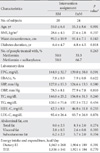1. Ziemer DC, Berkowitz KJ, Panayioto RM, El-Kebbi IM, Musey VC, Anderson LA, Wanko NS, Fowke ML, Brazier CW, Dunbar VG, Slocum W, Bacha GM, Gallina DL, Cook CB, Phillips LS. A simple meal plan emphasizing healthy food choices is as effective as an exchange-based meal plan for urban African Americans with type 2 diabetes. Diabetes Care. 2003. 26:1719–1724.
2. Bantle JP, Wylie-Rosett J, Albright AL, Apovian CM, Clark NG, Franz MJ, Hoogwerf BJ, Lichtenstein AH, Mayer-Davis E, Mooradian AD, Wheeler ML. Nutrition recommendations and interventions for diabetes: a position statement of the American Diabetes Association. Diabetes Care. 2008. 31:Suppl 1. S61–S78.
3. Nordmann AJ, Nordmann A, Briel M, Keller U, Yancy WS Jr, Brehm BJ, Bucher HC. Effects of low-carbohydrate vs low-fat diets on weight loss and cardiovascular risk factors: a meta-analysis of randomized controlled trials. Arch Intern Med. 2006. 166:285–293.
4. American Diabetes Association. Standards of medical care in diabetes: 2009. Diabetes Care. 2009. 32:Suppl 1. S13–S61.
5. Yang EJ, Kerver JM, Park YK, Kayitsinga J, Allison DB, Song WO. Carbohydrate intake and biomarkers of glycemic control among US adults: the third National Health and Nutrition Examination Survey (NHANES III). Am J Clin Nutr. 2003. 77:1426–1433.
6. Korea Centers for Disease Control and Prevention. The Third National Nutrition Examination Survey (KNHANES III), 2005. 2007. Seoul: Korea Centers for Disease Control and Prevention.
7. Korea Centers for Disease Control and Prevention. The Fourth National Nutrition Examination Survey (KNHANES IV-1), 2007. 2008. Seoul: Korea Centers for Disease Control and Prevention.
8. Park YM, Sohn CM, Jang HC. Correlation of carbohydrate intake with obesity in type 2 diabetes mellitus patients. J Korean Diet Assoc. 2006. 12:254–263.
9. Lee YN, Roh SY. The study of awareness and practice of Korean dietitians in food exchange lists, serving size and dietary guidelines. J Korean Diet Assoc. 2001. 7:9–18.
10. Pedersen SD, Kang J, Kline GA. Portion control plate for weight loss in obese patients with type 2 diabetes mellitus: a controlled clinical trial. Arch Intern Med. 2007. 167:1277–1283.
11. Raidl M, Spain K, Lanting R, Lockard M, Johnson S, Spencer M, Sant L, Welch J, Liddil A, Hartman-Cunningham M. The healthy diabetes plate. Prev Chronic Dis. 2007. 4:A12.
12. Ahn HJ, Koo BK, Jung JY, Kwon HR, Chung MY, Ku YH, Kim JT, Han KA, Min KW. Association between volume of bowls and the dietary intakes in subjects with type 2 diabetes. Korean Diabetes J. 2009. 33:335–343.
13. Ahn HJ, Ku YH, Eon YK, Seok HG, Kwon HR, Kim JT, Kim HJ, Park KS, Han KW, Min KW. Reduced rice bowl-based meal plan for carbohydrate intake and dietary pattern in type 2 diabetic patients. Korean Diabetes J. 2009. 33:suppl 8. 206.
14. Korean Diabetes Association. A guideline for diabetes education. 2006. 2nd ed. Seoul: Gold Agency;167.
15. Son SM. Rice based meal for prevention of obesity and chronic disease. Korean J Community Nutrition. 2001. 6:862–867.
16. Woo YJ, Lee HS, Kim WY. Individual diabetes nutrition education can help management for type II diabetes. Korean J Nutr. 2006. 39:641–648.
17. Jung ED, Chung DS, Lee JY. The correlation between visceral ount by computed tomography in type 2 diabetes. Korean Diabetes J. 2008. 32:418–427.
18. Wilson C, Brown T, Acton K, Gilliland S. Effects of clinical nutrition education and educator discipline on glycemic control outcomes in the Indian health service. Diabetes Care. 2003. 26:2500–2504.
19. UKPDS Group. UK Prospective Diabetes Study 7: response of fasting plasma glucose to diet therapy in newly presenting type II diabetic patients, UKPDS Group. Metabolism. 1990. 39:905–912.
20. Kim SH, Kang ES, Park SY, Lee SJ, Kim MJ, Yoo JS, Ahn CW, Cha BS, Lim SK, Lee HC. The effects of lifestyle modification on the metabolic parameters of type 2 diabetes. J Korean Diabetes Assoc. 2004. 28:441–451.
21. Khan MA, St Peter JV, Breen GA, Hartley GG, Vessey JT. Diabetes disease stage predicts weight loss outcomes with long-term appetite suppressants. Obes Res. 2000. 8:43–48.
22. Yu-Poth S, Zhao G, Etherton T, Naglak M, Jonnalagadda S, Kris-Etherton PM. Effects of the National Cholesterol Education Program's Step I and Step II dietary intervention programs on cardiovascular disease risk factors: a meta-analysis. Am J Clin Nutr. 1999. 69:632–646.
23. Barnard ND, Cohen J, Jenkins DJ, Turner-McGrievy G, Gloede L, Green A, Ferdowsian H. A low-fat vegan diet and a conventional diabetes diet in the treatment of type 2 diabetes: a randomized, controlled, 74-wk clinical trial. Am J Clin Nutr. 2009. 89:1588S–1596S.
24. Ahn HJ, Koo BK, Jung JY, Kwon HR, Kim HJ, Park KS, Han KA, Min KW. Bowl-based meal plan versus food exchange-based meal plan for dietary intake control in Korean type 2 diabetic patients. Korean Diabetes J. 2009. 33:155–163.







 PDF
PDF ePub
ePub Citation
Citation Print
Print



 XML Download
XML Download